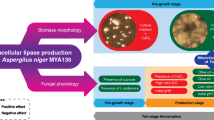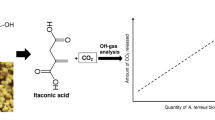Abstract
Aspergillus niger IFO 8541 was found to be an efficient biocatalyst for the biotransformation of β-ionone into hydroxy and oxo derivatives. The reaction had to be carried out with an inoculum made of about 4 × 107 fresh spores/l and with a preliminary growth period giving at least 3 g/l biomass. The fungus developed in the form of pellets when cultivated as free mycelium; entrapment of the microorganism in calcium alginate beads was an efficient way to mimic this feature in an aerated, stirred bioreactor. The biotransformation was carried out using a fed-batch mode of operation involving sequential precursor addition. β-Ionone stopped the fungal growth and was converted into metabolites only when the carbon source remained present in the medium; it was fully oxidized after sucrose exhaustion. These conditions allowed recovery of about 2.5 g/l aroma compounds after 230 h cultivation with a molar yield close to 100%.
Similar content being viewed by others
References
Blakeney AB, Mutton LL (1980) A simple colorimetric method for the determination of sugars in fruit and vegetables. J Sci Food Agric 31:889–897
Braun S, Vecht-Lifshitz E (1991) Mycelial morphology and metabolite production. Trends Biotechnol 9:63–68
Eikmeier H, Rehm HJ (1987) Stability of calcium-alginate during citric acid production of immobilized Aspergillus niger. Appl Microbiol Biotechnol 28:105–111
Enzell CR (1976) Terpenoid components of leaf and their relationship to smoking quality and aroma. Rec Adv Tobacco Sci 2:32–60
Enzell CR, Wahlberg I, Aasen AJ (1977) Isoprenoids and alkaloids of tabacco. Fortschr Chem Org Naturst 34:1–79
Hotop S, Möller J, Niehoff J, Schügerl K (1993) Influence of the preculture conditions on the pellet size distribution of Penicillium chrysogenum cultivations. Process Biochem 28:99–104
Iida M, Wakuri S, Mineki S, Nishitani K, Yamakawa K (1993) Microbial hydroxylation of 11, 13-dehydrosantonim by Aspergillus niger. J Ferment Bioeng 76:266–299
Janssens L, De Pooter HL, Schamp NM, Vandame EJ (1992) Production of flavours by microorganisms. Process Biochem 27:195–215
Krasnobajew V (1982) Microbiological transformations of ionone compounds. US Patent 4, 311, 860
Larroche C, Tallu B, Gros JB (1988)Aroma production by spores of Penicillium roquefortii on a synthetic medium. J Ind Microbiol 3:1–8
Metz B, Kossen NWF (1977) The growth of molds in the form of pellets-a literature review. Biotechnol Bioeng 19:781–799
Michel FC Jr, Grulke EA, Reddy CA (1992) A kinetic model for the fungal pellet lifecycle. AIChE J 38:1449–1460
Mikami Y, Watanabe E, Fukunaga Y, Kisaki T (1978) Formation of 2S-hydroxy-β-ionone and 4ɛ-hydroxy-β-ionone by microbial hydroxylation of β-ionone. Agric Biol Chem 42:1075–1077
Mikami Y, Fukunaga Y, Arita M, Kisaki T (1981) Microbial transformation of β-ionone and β-methylionone. Appl Env Microbiol 41:610–617
Ohloff G (1978) Recent developments in the field of naturally-occuring aroma components. Fortschr Chem Org Naturst 35:431–527
Roels JA (1983) Energetics and kinetics in biotechnology. Elsevier Biomedical Press, Amsterdam
Schreier P (1988) Biotechnology and flavour production. In: Durand G, Bobichon L, Florent J (eds) Proc 8th International Biotechnology Symposium, vol 2. Soc Fr Microbiol, Paris, pp 869–883
Slein MW (1965) D-Glucose determination with hexokinase and glucose 6-phosphate dehydrogenase. In: Bergmeyer HU (ed) Methods in enzymatic analysis. Academic Press, New York, London, p 117
Smith LL (1984) Steroids. In: Kieslich K (ed) Biotechnology, Vol 6a. Verlag Chemie, Weinheim, pp 31–78
Sode K, Karube I, Araki R, Mikami Y (1989) Microbial conversion of β-ionone by immobilized Aspergillus niger in the presence of an organic solvent. Biotechnol Bioeng 33:1191–1195
Tucker KG, Thomas CR (1994) Inoculum effect on fungal morphology: shake flasks vs agitated bioreactors. Biotechnol Tech 8:153–158
Vogel AI (1961) Quantitative inorganic analysis including elementary instrumental analysis, 3rd edn. Longmans, London
Welsh FW, Murray WD, Williams RE (1989) Microbiological and enzymatic production of flavour and fragnance chemicals. CRC Crit Rev Biotechnol 9:105–169
Yamazaki Y, Hayashi Y, Arita M, Hieda T, Mikami Y (1988) Microbial conversion of α-ionone, α-methylionone and α-isomethylionone. Appl Env Microbiol 54:2354–2360
Author information
Authors and Affiliations
Rights and permissions
About this article
Cite this article
Larroche, C., Cruely, C. & Gros, J.B. Fed-batch biotransformation of β-ionone by Aspergillus niger . Appl Microbiol Biotechnol 43, 222–227 (1995). https://doi.org/10.1007/BF00172816
Received:
Revised:
Accepted:
Issue Date:
DOI: https://doi.org/10.1007/BF00172816




